All about planting gooseberries with closed and open root systems
Proper planting of gooseberries is an important stage in the successful cultivation of the crop. In order for the bushes to take root, grow strong and healthy, and subsequently produce a bountiful harvest, it is important to know when you can plant gooseberries, at what distance from each other to place the bushes and which planting method to choose for a particular variety and region. Read about this in our article.
How to properly plant gooseberries with closed and open root systems
Important activities when planting gooseberries are the choice of variety and location and preparatory work. The timing is influenced by various factors - from the variety to the climate in the region.
Gooseberry planting dates
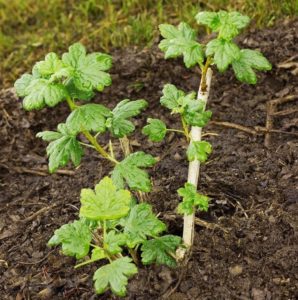
When to plant gooseberries depends on the variety, climate in the region and the condition of the planting material. It is better to do this in the fall, from late September to mid-October. The daytime temperature should not be lower than +10...+15°C, and the earth should remain warm since the summer. Then the root system will grow many small roots and become well strengthened. Approximately, planting is carried out no later than a month before the first frost. If a premature cold snap occurs, it is better to postpone it until spring, otherwise the seedlings will not have time to take root and will freeze.
Spring planting is done early, when the snow melts, before the buds swell. In the south - in March; in the northern regions, planting may take until the end of April.
Reference. Seedlings with a closed root system can be planted at any time throughout the growing season, even in summer.
The timing of autumn planting of gooseberries varies slightly in different regions:
- in the Urals and Siberia – at the end of the calendar summer and the first days of September;
- in the middle zone and Moscow region – from late September to mid-October;
- in the south, planting can continue until the beginning of November.
Selecting a variety and seedling
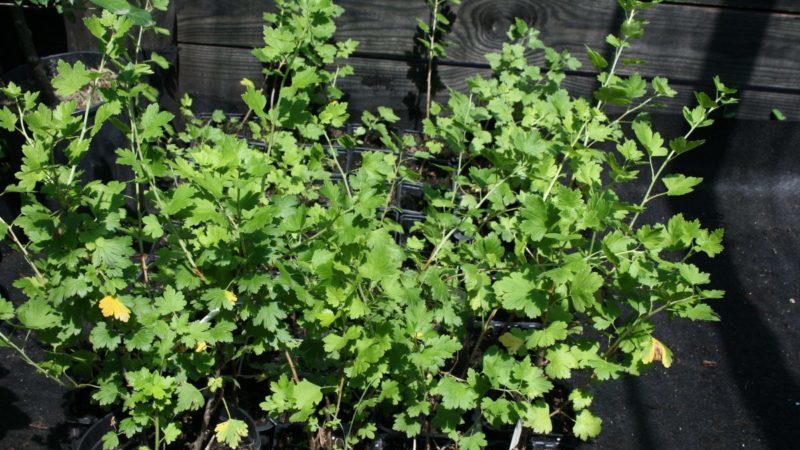
Seedlings aged 1, 2 and 3 years are available for sale. Each should have several healthy shoots about 30 cm long, evenly distributed on the trunk:
- for 1-year-olds – 3-5 pieces;
- for 2-year-olds – 5-7 pieces;
- for 3-year-olds – 6-8 pieces. first and second order.
The root system must consist of at least 3 skeletal roots 20-25 cm long. Mechanical damage to the above-ground or underground parts is unacceptable.
Seedlings come with closed and open root systems. In the first case, all the roots of the planting material are inside the ball of earth, so they are not damaged during transplantation. This is a great advantage, because such plants have a stronger above-ground part, take root better after planting and begin to bear fruit earlier.
However, there is also a drawback - in the coma of the earth the condition of the roots is not visible. And if any disease begins to develop there, it will only be discovered over time. It should also be taken into account that seedlings with a closed root system are more expensive.
An exposed root system is bare roots that can be carefully inspected. Traces of damage by bacteria or pests are immediately visible on them, the general condition, the degree of root development and the presence of small roots are visible. Such seedlings are cheaper, but they also have disadvantages.
Since the root system is exposed, it cannot be kept out of the soil for long. It is advisable to plant such seedlings on the day of purchase.As a last resort, dig it in a temporary place or dip the roots in mud mash and wrap them in plastic to prevent dehydration and drying out.
The gooseberry variety is chosen depending on the region:
- In the central and northwestern regions, mid-late and late varieties are planted: Grushenka, Green rain, Kolobok, Affectionate, Tender, Russian yellow, Spring seedling, Bitsevsky.
- In the central black earth - mid-season: Aristocrat, Stargazer, Sailor, Orpheus, Prune seedling, Sunny Bunny.
- In the south, varieties of different ripening periods grow. The main criterion for them is resistance to heat and drought: Krasnodarets, Lights of Krasnodar, Kubanets, In Memory of Komarov.
- In the Volga regions, Siberia and the Far East, winter-hardy gooseberries take root: Avangard (Jubilee), Beryl, Cooperator, Kovcheg (Ural Thornless), Red East, Samurai, Thornless Chelyabinsk, Black Drop, SP GF-58.
Choosing a planting site and preparing the soil
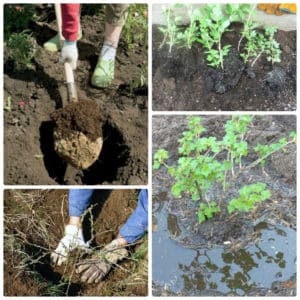
The choice of location for gooseberries is influenced by the characteristics of the plant:
- Powerful root system. The roots grow in breadth, thanks to which the gooseberry can withstand drought, but requires a lot of space. Stagnant water makes the bushes sick, so they are not planted in lowlands and places with close groundwater.
- Light-loving culture. Gooseberries love plenty of sunlight, but tolerate slight shading well.
- The soil required is neutral or slightly acidic. It should be nutritious and, at the same time, loose, since air exchange is important for the roots.
Gooseberries need a well-lit, ventilated place in an area with nutritious and loose soil, above groundwater.Heavy and clayey soil will need some work to make it suitable for gooseberries. Mulching, the use of EM preparations and green manure will help with this. These techniques enrich the soil and make it looser and lighter. If the soil is acidic, it is deoxidized with dolomite flour or lime.
Reference. Plants growing on the site will help determine the acidity of the soil. Sorrel, horsetail, and moss grow on acidic soil.
Gooseberries are not planted after raspberries, currants and other varieties of gooseberries, because these crops are susceptible to the same diseases and pests. Can be planted after peas, potatoes, beets.
Before planting, all weeds, especially perennials, are removed from the site. Those that sit firmly in the ground do not pull them out, but dig them up to remove them by the roots. This will provide the bushes with better nutrition, since the weeds take away a lot of useful substances, and will make further care easier - because of the sharp thorns, the ground around the gooseberries is not so easy to weed.
Then the area is dug up and holes are marked. When planting, the distance between gooseberry bushes is at least 1.5 m - the bushes are spreading and should not interfere with each other.
Landing technology
For gooseberries, dig a hole 2 times wider and deeper than the volume of the roots of the seedling. The top fertile layer is carefully separated, mixed with well-rotted manure in a 1:1 ratio and a matchbox of potassium sulfate and double superphosphate is added. You can pour a handful of wood ash (about 300 g) into the bottom of the dug hole. It will serve as potassium fertilizer. Potassium increases the sugar content in fruits, but its deficiency reduces the yield and decorative qualities of the shrub. These fertilizers will be enough for the bush for the first 1-2 years.If there is a lot of clay in the soil, add a bucket of coarse river sand.
Attention! When applying manure, it is important not to oversaturate the soil with nitrogen. Too oily soil and excess organic matter worsen the immunity of young plants, they become brittle and vulnerable to powdery mildew.
Before planting, the roots of the seedling are dipped for 30 minutes in a biostimulator solution, for example, HB-101 (2 drops per 1 liter of water). If there is no suitable product, you can at least use water.
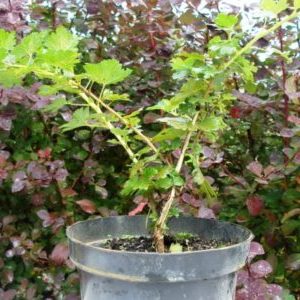
Plant gooseberries vertically, deepening the root collar by 6-10 cm (depending on the size of the shoots). The roots are straightened and, carefully holding the crown, sprinkled with prepared soil mixture. At the same time, shake the bush a little so that the earth fills the voids between the roots. Then the soil in the tree trunk circle is compacted, watered and mulched so that a crust does not form. The soil is kept moist by watering as needed. This is especially true in dry and warm autumn. With natural precipitation, watering is not necessary.
When planting in spring, the soil is prepared in the fall by digging and fertilizing. After planting, above-ground shoots are cut to 15-20 cm, leaving 3-4 buds. There is no need to do this in the fall.
How to plant gooseberries
Gooseberries are propagated in several ways: by dividing the bush, layering, cuttings and seeds. Let's describe each and consider what their advantages and disadvantages are.
Dividing the bush
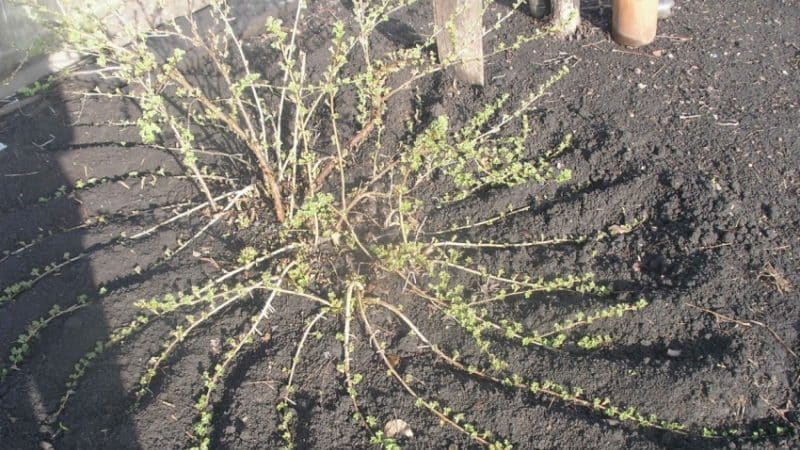
This method is used when they want to move the bush to a new place or it has grown greatly. The age of the plant does not matter, but it must have healthy young shoots.If a bush has been growing in one place for 5 or more years, division is even indicated for it - the procedure increases productivity and helps increase the size of the berries, rejuvenates the root system and renews the soil.
In the fall, when the leaves fall, or in early spring, the bush is dug up and, together with the rhizome, divided into parts (at least 3-4). Immediately after this they are planted in a new place.
Reference. When dividing the bush in the fall, there is a greater chance that the gooseberries will begin to bear fruit the next year.
Care during rooting is similar to that described above.
The advantages of the method are simplicity and survival rate of planting material. The disadvantage is the labor-intensive process, especially when dividing a large bush.
By layering

This is an even simpler and more effective way to propagate gooseberries. Its great advantage is not only that even an inexperienced gardener can handle it, but also that the planting material is separated from the mother bush after root formation. The cuttings will take root and become stronger while not being separated from the main plant. It is also convenient that a lot of young seedlings are obtained.
Shoots are used green or combined, i.e. green with part of a woody 2-year-old shoot. Gooseberries are propagated by horizontal, arcuate and vertical layering.
Reproduction by horizontal layering is carried out in the spring before buds open (in March - April) or in the fall (in October):
- Select 5-7 healthy young shoots.
- Under them, grooves are dug 10 cm deep.
- The shoots are lowered into the grooves and pinned to the ground with wire or wooden hooks.
- Sprinkle with soil, water and mulch.
- The soil is kept moderately moist and care is taken to ensure that the cuttings do not rot.
- When they take root, young vertical shoots will appear from them.They are sprinkled with humus. After 10-15 days they will rise above the ground again and they will be spudded again.
- After the leaves fall, the cuttings are separated from the mother bush, cut into pieces so that each has roots and shoots, and planted in a permanent place.
Propagation by arcuate layering is used in the spring. The technique is similar to the previous one, only the layers are bent in an arc and pinned to the ground in one place. The end of the stem is brought out of the ground and trimmed to improve branching. Separate rooted shoots from the mother bush in the fall. You can pin several cuttings from one, and each will produce only one new shoot, but it will be more powerful and stronger than with the horizontal method. This method is usually used to obtain seedlings from young bushes.
Vertical layering is used to propagate old gooseberry bushes, which are subsequently removed. However, it will not be possible to get a harvest this year. In spring, all branches are cut off from the bush. After some time, the young shoots will grow 20-25 cm. Half of them are sprinkled with humus. During the summer, the soil is filled up and watered well. To prevent it from eroding, a groove is formed around it for irrigation. By autumn, roots form on the sprinkled shoots. Then they are carefully dug up and planted in a permanent place.
Cuttings
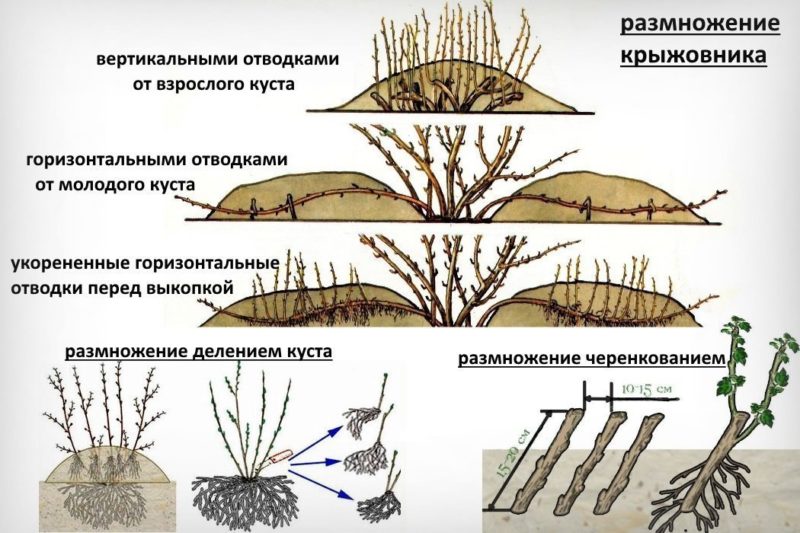
Cuttings are used throughout the growing season. Green cuttings are rooted in summer (early July), combined and lignified cuttings - in spring and autumn (mid-September).
Important! The older the cutting, the worse it takes root.
Using sharp, disinfected scissors, healthy, strong shoots are cut from the bush. Each one should have at least 2 buds and 2 leaves above them. The upper cut is made horizontal, the lower cut at an angle of 45°.After cutting, the cuttings are placed in a growth stimulator for several hours. The subsequent technology varies:
- Green cuttings are placed in a greenhouse or greenhouse at a distance of 5 cm from each other, deepened by 3 cm. The temperature is maintained no higher than +30...+35°C. The cuttings are provided with regular watering. After rooting, they are planted in a permanent place. When planting, 3 buds are left on the surface.
- Cuttings from lignified shoots 15-20 cm long are tied into a bundle and placed vertically in a container filled with a mixture of sand and peat. The container is placed in a cool room for a month. The soil is periodically moistened. An influx gradually forms at the ends of the cuttings. After a month, they are separated, sprinkled with sawdust and left until spring. Then they are planted in the ground at an angle, leaving 2-3 buds above the ground. By autumn, the cuttings will take root and are planted in a permanent place.
- Combined cuttings are cut off with a part of the woody shoot (3-5 cm) and placed in water. You can add a little growth stimulant. When roots form, the cuttings are planted in a permanent place. By autumn they will take root well.
Cuttings are no less popular than propagation by layering. It also provides a lot of planting material and a guarantee of success.
Propagation by seeds
This is the most difficult and unpopular way. Only experienced gardeners undertake it. The seeds can produce a plant that does not have the varietal characteristics of the parent plant. Hybrids are not suitable for this at all. Seedlings take a long time to grow, so you won’t be able to get a harvest quickly.
Seeds are removed from ripe berries, washed thoroughly in warm water to remove the pulp, and dried on a clean, dry cloth. A soil mixture of fertile soil, river sand and humus is poured into the containers.The seeds are laid on the surface at a distance of 5 cm from each other, lightly sprinkled with soil and watered with a spray bottle. The container is covered with film and placed in a cool place with a temperature of +3...+5°C.
In spring, seedlings are moved to the site. Each one must have at least 2 leaves.
Conclusion
Proper planting is the key to further successful cultivation and a rich harvest. Knowing how to properly plant gooseberries in spring, summer and autumn, applying useful tips in practice, taking into account the characteristics and survival rate of varieties in different regions, even an inexperienced gardener will cope with all stages of growing and propagating the crop.